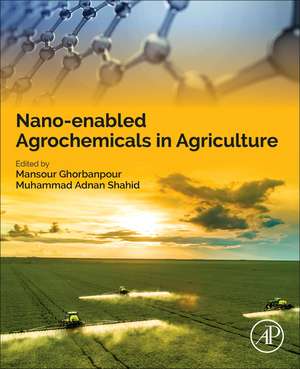Nano-enabled Agrochemicals in Agriculture
Editat de Mansour Ghorbanpour, Muhammad Adnan Shahiden Limba Engleză Paperback – 17 mar 2022
Although the markets for nanoproducts and nanoformulations continue to increase, there are also growing concerns regarding the fate and behavior of nanomaterials in environmental systems. Exploring important topics related to nanotechnology and nanomaterials, the book includes the use of nanochemicals in insect pest management, as nanofungicides, nanoherbicides, micronutrient supply, and nanosensors to monitor crop and soil health conditions, from detection of agrochemicals to their slow release of agrochemicals, and their impact on related environs.
This book will serve as an excellent resource for a wide range of plant scientists who have concerns about nanomaterial interactions with terrestrial and aquatic plants.
- Focuses on emerging important topics related to nanotechnology and nanomaterials on agricultural systems
- Emphasizes new applications of nanomaterials in the agricultural sciences, from fertilizers to irrigation systems
- Addresses concerns about nanomaterial interactions with terrestrial and aquatic plants
Preț: 793.95 lei
Preț vechi: 1034.27 lei
-23% Nou
Puncte Express: 1191
Preț estimativ în valută:
151.93€ • 156.97$ • 126.38£
151.93€ • 156.97$ • 126.38£
Carte tipărită la comandă
Livrare economică 12-26 martie
Preluare comenzi: 021 569.72.76
Specificații
ISBN-13: 9780323910095
ISBN-10: 0323910092
Pagini: 568
Ilustrații: 100 illustrations (25 in full color)
Dimensiuni: 191 x 235 x 31 mm
Greutate: 0.97 kg
Editura: ELSEVIER SCIENCE
ISBN-10: 0323910092
Pagini: 568
Ilustrații: 100 illustrations (25 in full color)
Dimensiuni: 191 x 235 x 31 mm
Greutate: 0.97 kg
Editura: ELSEVIER SCIENCE
Cuprins
1. The Role of Nanotechnology to Combat Major Recent Worldwide Challenges
2. Classification of nanomaterials and their physical and chemical nature
3. The theory of relativity effect in nanoparticles: Deciphering of unknown effects
4. Eco-friendly routes for obtaining nanoparticles and their application in agro-industry
5. The mechanism involved in the synthesis of biogenic nanoparticles
6. Advanced analytical techniques for physico-chemical characterization of nano-materials
7. Nanotechnology for cargo delivery with a special emphasis on pesticide, herbicide and fertilizer
8. Nano-biofertilizers for enhanced nutrient use efficiency
9. Nanopriming technology for improving crop plants under stressful conditions: concepts and methods
10. Applications of nanotechnology in precision agriculture
11. Applications of algal nanoparticles in agriculture
12. Silver and zinc nanoparticles in improvement of agricultural crops
13. Biogenic nanoparticles and their application for removal of organic contaminants from water and wastewater
14. Stimulatory role of nanomaterials on agricultural crops
15. Green Synthesis of Nanoparticles and their uses in Agriculture
16. A Comprehensive Review on Nanopesticides and Nanofertilizers- A boon for Agriculture
17. Nano-enabled Agrochemicals for Sustainable Agriculture
18. Encapsulation of Fungicide Nanoparticles Using Functionalized Graphene and its Application against Phytopathogenic Rhizoctonia Solani
19. Nanotoxicity based studies (phytotoxicity, cytotoxicity, genotoxicity and ecotoxicity) in agriculture
20. Engineered nanomaterial-mediated changes in growth and development of common agricultural crops
21. Biosynthesis and green synthesis of nano-particles and their use in agriculture
22. Nanoparticle-based solutions for diagnosis and management of fungal plant pathogens
23. Current Status and Future Prospects of Nanoparticles as plant genetic materials carrier
24. Current developments in nanotechnology for the growth of different industrial sectors: 2010-2020
25. Impacts of nanomaterials on metabolic profiling of agricultural crops
26. Polymeric Nanoparticle-based Insecticide: a critical review of agriculture production
27. Nanodelivery System: In the agriculture sector
28. Nanotechnology, a new tool for agriculture and agroindustry
29. Synthesis of different TiO2 nanostructures using Central Composite Design optimization method and application of TiO2-nanobelt for water microorganism’s purification
2. Classification of nanomaterials and their physical and chemical nature
3. The theory of relativity effect in nanoparticles: Deciphering of unknown effects
4. Eco-friendly routes for obtaining nanoparticles and their application in agro-industry
5. The mechanism involved in the synthesis of biogenic nanoparticles
6. Advanced analytical techniques for physico-chemical characterization of nano-materials
7. Nanotechnology for cargo delivery with a special emphasis on pesticide, herbicide and fertilizer
8. Nano-biofertilizers for enhanced nutrient use efficiency
9. Nanopriming technology for improving crop plants under stressful conditions: concepts and methods
10. Applications of nanotechnology in precision agriculture
11. Applications of algal nanoparticles in agriculture
12. Silver and zinc nanoparticles in improvement of agricultural crops
13. Biogenic nanoparticles and their application for removal of organic contaminants from water and wastewater
14. Stimulatory role of nanomaterials on agricultural crops
15. Green Synthesis of Nanoparticles and their uses in Agriculture
16. A Comprehensive Review on Nanopesticides and Nanofertilizers- A boon for Agriculture
17. Nano-enabled Agrochemicals for Sustainable Agriculture
18. Encapsulation of Fungicide Nanoparticles Using Functionalized Graphene and its Application against Phytopathogenic Rhizoctonia Solani
19. Nanotoxicity based studies (phytotoxicity, cytotoxicity, genotoxicity and ecotoxicity) in agriculture
20. Engineered nanomaterial-mediated changes in growth and development of common agricultural crops
21. Biosynthesis and green synthesis of nano-particles and their use in agriculture
22. Nanoparticle-based solutions for diagnosis and management of fungal plant pathogens
23. Current Status and Future Prospects of Nanoparticles as plant genetic materials carrier
24. Current developments in nanotechnology for the growth of different industrial sectors: 2010-2020
25. Impacts of nanomaterials on metabolic profiling of agricultural crops
26. Polymeric Nanoparticle-based Insecticide: a critical review of agriculture production
27. Nanodelivery System: In the agriculture sector
28. Nanotechnology, a new tool for agriculture and agroindustry
29. Synthesis of different TiO2 nanostructures using Central Composite Design optimization method and application of TiO2-nanobelt for water microorganism’s purification
